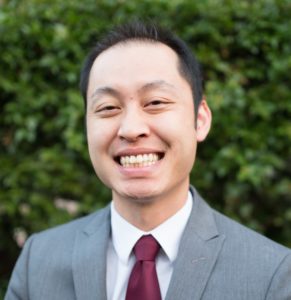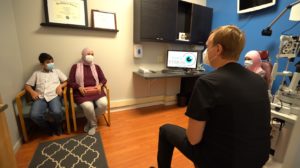sponsored content
April 15, 2022
By Justin Kwan, OD, FAAO
To ease potential worries, emphasize the value of investing in their child’s future vision and kids’ ability to quickly achieve success as contact lens wearers.
Parents trust their ECPs when it comes to their child’s vision — and the guidance for the best path forward — following a comprehensive eye exam. Still, your myopia diagnosis and prescription of MiSight 1 day treatment to slow their age-appropriate* child’s myopia progression may spark initial concerns for some moms.
For example, the mother sitting next to her child in your exam room might be torn between wanting the best long-term vision and eye health possible for her child and her countering worries about cost and whether her young son or daughter with myopia can easily insert their lenses in the morning before the school bus arrives.
In fact, in a recent survey of 1,000 mothers, three out of four moms cite at least one barrier in their decision to start treatment with MiSight 1 day.1 Additionally, a mom’s own experience with myopia and whether her child is already a contact lens wearer may influence her purchasing decision.
Despite initial issues that may come up in the exam room, don’t be deterred. Remember, you are a parent’s vital and valued source when it comes to their child’s vision.
Share the Findings: Children Adapt Quickly to Contacts
When considering MiSight 1 day, most moms are concerned about their children wearing contact lenses, and this sentiment rings especially true for mothers of children with myopia.1 In this scenario, remember, science is on your side.
First, communicate the fact that children as young as 8 can quickly learn to handle contact lenses and achieve a high level of capability within the first month. For moms worried about potential adverse events such as ocular infections, point to study results that validate contact lens safety in young wearers.3
Another key point to keep in your treatment discussion toolbox: most kids are highly motivated to wear contacts from the get-go, and a majority of children as young as 8 prefer to wear contacts over glasses when given the option.2 A spectacle-free child can enjoy a heightened quality of life in the activities they enjoy and gain a confidence boost in their appearance.
Since moms also appreciate ongoing support during their child’s contact lens adaptation period, emphasize your practice’s commitment to the child’s wearing success, and assure them that a dedicated staff member will be there to help troubleshoot any issues that may arise at home.
Confirm the Investment Value of Preserved Vision
A mother’s second most significant barrier to purchase is price, especially if her child with myopia is already a contact lens (CL) wearer.1 In these cases, reinforce the fact that younger children with myopia are the most rapid progressors, and acting now can help minimize future trouble down the road, including the increased risk of developing serious, sight-threatening conditions such as glaucoma, a retinal tear, or macular maculopathy.4
Additionally, communicate MiSight’s significant value as the first FDA-approved* product proven to slow the progression of myopia in children, aged 8-12 at the initiation of treatment.†5
Speak to the Science
Moms with myopic kids who are already CL wearers may also wonder about the effectiveness of treatment.1 ECPs can speak with authority about the science behind the lens and the compelling study results, including the fact that age-appropriate* children who wore MiSight experienced a reduction in myopia progression by 59% on average and a 52% reduction in axial lengthening, on average.†
Communicate Your Commitment to Myopia Control
Moms may also be unaware that their doctor offers a myopia control treatment solution that is age-appropriate* for their child.1 This underscores the need for ECPs to educate parents about myopia early and often. Consistency is key, as the worsening of myopia and the solution of MiSight are likely new concepts.
It’s important to listen to parents’ concerns when discussing their child’s myopia, but it’s equally important to speak with confidence about why you’re prescribing MiSight 1 day.
After all, parents trust you.
 |
As Senior Manager of Myopia Management at CooperVision, Justin Kwan, OD, FAAO, is responsible for supporting myopia management programs in partnership with eye care professionals across the U.S. and Canada. Dr. Kwan is also the current president of the Chicago North Side Optometric Society, chair of the American Academy of Optometry Fellows Doing Research special interest group, editor-in-chief of Clinical and Refractive Optometry, and a reviewer for many professional journals. He is a 2009 graduate of the University of California, Berkeley, and he has completed a dry eye and contact lens research fellowship/residency at SCCO. |
References
*Indications for use: MiSight® 1 day (omafilcon A) soft (hydrophilic) contact lenses for daily wear are indicated for the correction of myopic ametropia and for slowing the progression of myopia in children with non-diseased eyes, who at the initiation of treatment are 8-12 years of age and have a refraction of -0.75 to -4.00 diopters (spherical equivalent) with ≤ 0.75 diopters of astigmatism. The lens is to be discarded after each removal.
†Compared to a single vision 1 day lens over a 3-year period.
‡ Children with myopia fit with MiSight® 1 day contact lenses ages 8-15 continued to experience slowed myopia progression as long as they remained wearing the lens as prescribed.
1 MiSight 1 Day DTC 2.0 Campaign Wrap Report. CooperVision. Nov. 14, 2021.
2 Sulley A. Wearer experience and subjective responses with dual focus compared to spherical, single vision soft contact lenses in children during a 3-year clinical trial. AAO 2019 Poster Presentation.
3 Woods J, Jones D, Jones L, et al. Ocular health of children wearing daily disposable contact lenses over a 6-year period. Cont Lens Anterior Eye. 2021 Aug;44(4):101391.
4 Flitcroft DI. The complex interactions of retinal, optical and environmental factors in myopia aetiology. Prog Retin Eye Res. 2012;31:622-60.
5 Chamberlain P, Peixoto-de-Matos SC, Logan NS, et al. A 3-year Randomized Clinical Trial of MiSight Lenses for Myopia Control. Optom Visc Sci. 2019 Aug;96(8):556-567.














